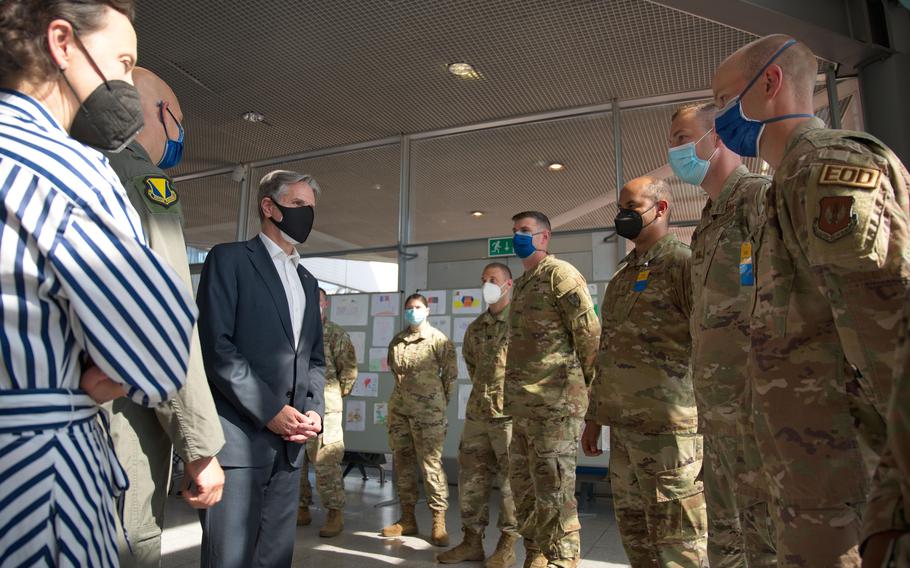
U.S. Secretary of State Antony J. Blinken greets service members at Ramstein Air Base, Sept. 8, 2021. (Branden Rae/U.S. Air Force)
BANGKOK — Secretary of State Antony Blinken on Thursday denied that this week’s deadly missile explosion in Poland and subsequent disagreements of its origins revealed a lack of communication and coordination with Ukraine following contradictory statements between Ukrainian President Volodymyr Zelenskyy and Western leaders.
“We’ve been in regular contact with our Ukrainian partners throughout. I spoke to my Ukrainian counterpart … We’re sharing the information that we have and, again, the investigation is ongoing,” Blinken told reporters during a news conference at the Asia-Pacific Economic Cooperation forum in Thailand.
The top U.S. diplomat ignored a question about whether the incident raised questions about the credibility of Zelenskyy’s claims. Instead, Blinken blamed Moscow for placing immense pressure on its smaller neighbor, which again this week has scrambled to intercept waves of Russian missiles aimed at civilian facilities throughout the country. Western officials believe it was an errant Ukrainian air defense missile that fell across the border into Poland on Tuesday, killing two.
Blinken’s comments come as Zelenskyy waffled on his claim that the explosion had to be Russian projectiles. He said earlier this week that he had “no doubt that it was not our missile,” forcing top U.S. and NATO officials to make a rare public break with the Ukrainian leader — a dramatic departure from their strenuous efforts to create as little daylight between them and Zelenskyy to show a united front against Russia.
“Russia is responsible for what happened,” Blinken said. “What we’re seeing every single day now is Russia raining down missiles in Ukraine, seeking to destroy its critical infrastructure, targeting the ability Ukraine has to keep the lights on, to keep the heat going to, to allow the country to simply live and move forward,” he said.
Zelenskyy backtracked some on Thursday, telling an audience at an economic forum, “I don’t know 100 percent — I think the world also doesn’t 100 percent know what happened.”
Hours earlier, when President Biden was asked about Zelenskyy’s claims, he said he disagreed with his assessment, saying “that’s not the evidence.” NATO Secretary General Jens Stoltenberg also said there was “no indication” the missile strike was the result of an attack by Russia.
U.S. officials said they were simply acting in accordance with the best assessments from their intelligence services, including information substantiating that the explosion was from at least one or as many as two Ukrainian SA-10 surface-to-air missiles that went off course, said a person familiar with new intelligence reporting.
Two senior U.S. administration officials said they would not dispute the characterization of intelligence linking Ukrainian missiles to the explosion. The officials all spoke on the condition of anonymity to discuss sensitive intelligence matters
Instead of focusing on U.S. differences with Zelenskyy’s remarks, Blinken pledged to send more military assistance to help Ukraine fend off Russian missile strikes.
“Ukraine has a right to defend itself, and we’re committed to supporting Ukraine in every effort,” he said.
Ukrainian officials hope the missile incident will re-energize efforts in the West to provide sophisticated missile defense systems.
The Ukrainian SA-10 missiles U.S. intelligence officials believe were involved in the explosion are older and less reliable than the newer missile defense systems Kyiv received from the West that have intercepted dozens of incoming Russian missiles. U.S.-supplied NASAMS, for example, are a higher quality ground-based missile defense weapon.
If Ukraine did inadvertently shoot an SA-10 missile deep into Polish territory, this would not be the first case of a Soviet-era missile defense system missing its mark. Syrian air defense systems, for instance, have in the past gone off course, landing in northern Jordan or rural Lebanon.
Blinken’s remarks came on the second day of his meetings in Bangkok for the Asia-Pacific Economic Cooperation forum, or APEC, where leaders are hoping to cooperate on a range of issues including COVID-19 responses, the resumption of international travel and lingering supply chain issues.
Biden is skipping the forum to attend his granddaughter’s wedding. In his place, Blinken and Vice President Harris are delivering remarks and holding bilateral meetings aimed at strengthening the United States’ economic integration in the Asia-Pacific — a region that accounts for about two-thirds of global economic growth.
Blinken said “what we do now” will determine the future of freedom and prosperity in the region and “will shape the trajectory of the 21st century.”
Blinken was joined at the forum by U.S. Trade Representative Katherine Tai who told reporters Thursday that the United States seeks to use trade policy to elevate women and entrepreneurs and “unlock economic opportunities for underrepresented parts of our populations.”
Harris is scheduled to give a speech at the APEC CEO summit on Friday where she will detail the Biden administration’s economic agenda for the Asia-Pacific region.
“The central message of her remarks will be that the United States has an enduring economic commitment to the Indo-Pacific, and there is no better partner for the economies and companies of the Indo-Pacific than the United States of America,” said a senior administration official in advance of the trip.